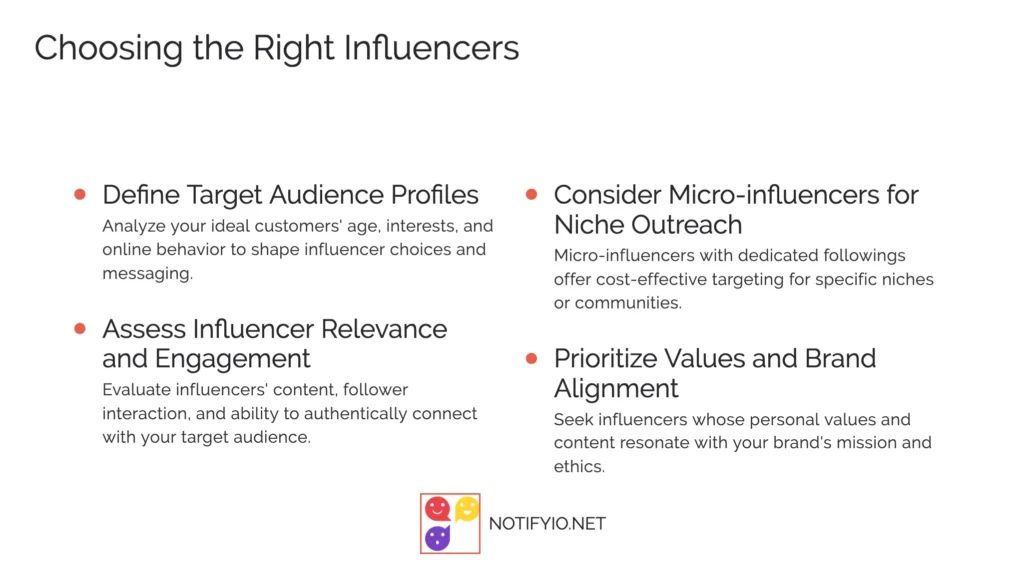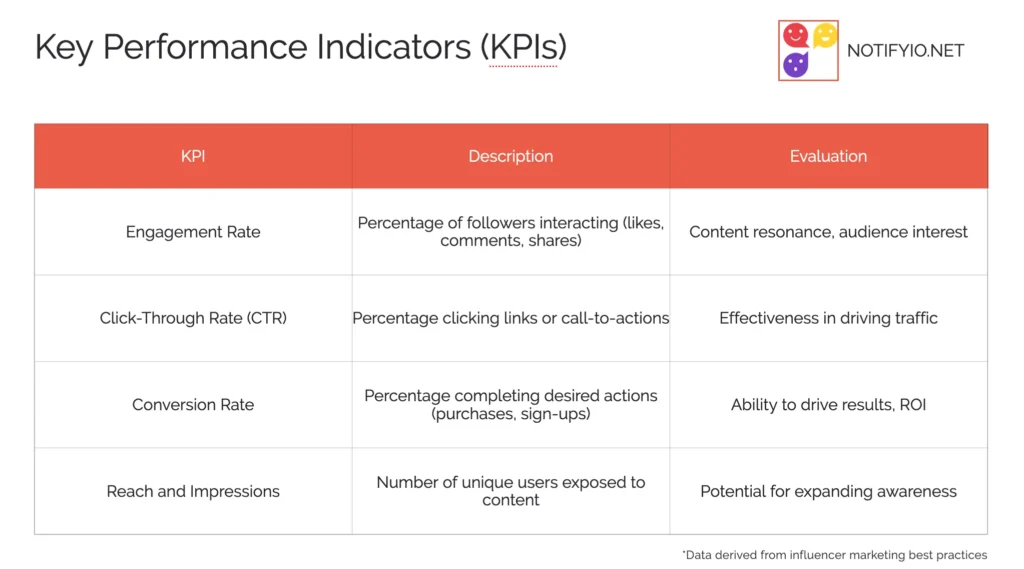Influencer marketing is now a key strategy for startups aiming for success. This guide will explore how influencer marketing for startups can use the appeal of big social media names. It will show how to step up brand awareness, sell more, and grow faster.
Startups can make strong connections with target audiences, gain trust, and become well-known online by teaming up with popular social media personalities. In this guide, you will learn about picking the right influencers, making influencer campaigns that draw people in, tracking success, and keeping a good relationship with influencers.
Key Takeaways
- Leveraging influencers allows startups to tap into highly engaged and targeted audiences.
- Successful influencer marketing campaigns can significantly boost brand awareness and drive conversions.
- Identifying the right influencers who align with your brand’s values and target audience is crucial.
- Crafting compelling content and fostering authentic partnerships are key to effective influencer marketing.
- Tracking key performance indicators (KPIs) and analyzing campaign data enables data-driven optimization.

Understanding the Power of Influencer Marketing
In our digital time, influencer marketing stands out. It’s a great way for startups to reach out. They connect with their target audience and boost brand awareness. It’s different from regular ads because it uses the strong bond between influencers and their followers in a niche.
What is Influencer Marketing?
Influencer marketing uses the power of social media. It involves working with people who are known and trusted in their fields. This way, startups get to speak to lots of interested people through the influencers they work with.
Why Influencer Marketing Works for Startups
For startups, this way of marketing is smart and affordable. They can stretch their marketing budgets further. This is because partnering with influencers often leads to a bigger roi. The right influencers quickly spread the word and build trust in the startup’s brand.
Types of Influencers and Their Reach
Influencers are put into groups based on their following and how much their followers interact. Micro-influencers are focused. They usually don’t cost as much. This makes them a good option for startups targeting particular people. Macro-influencers and celebrities, on the other hand, offer wide reach but can be more expensive.
| Influencer Type | Follower Count | Engagement Rate |
|---|---|---|
| Nano-influencers | 1,000 – 10,000 | 8.8% |
| Micro-influencers | 10,000 – 100,000 | 5.7% |
| Macro-influencers | 100,000 – 1,000,000 | 2.4% |
| Mega-influencers | Over 1,000,000 | 1.6% |
It’s not just about an influencer’s reach. When choosing who to work with, startups should also look at their engagement rate. This number shows how well an influencer connects with their audience.
Setting Objectives for Your Influencer Marketing Campaign
For a new business, setting clear marketing goals is key before starting an influencer marketing campaign. It’s vital to know your target audience well. This means identifying who they are, what they like, and where they hang out online. Startups need this info to reach them effectively.
Defining Your Target Audience
Success in influencer marketing comes from connecting with the right people. You must know your audience deeply. This is through studying market trends and learning from your current customers. Knowing their interests and online habits helps you form a solid influencer strategy.
Establishing Campaign Goals
Once you know your target audience, it’s time to set marketing goals for your campaign. Ask yourself if you want to raise brand awareness, get more leads, or up your sales. You need clear, specific goals for each. This helps you pick the right influencers and create fitting content for your campaign.
Choosing the Right Metrics to Measure Success
Measuring your campaign’s success is crucial. It means picking the right things to measure, like how many people interact with your content, see your website, or buy your products. Use tools from influencer platforms to track these metrics. They allow you to tweak your strategy in real time for better results.
| Campaign Goal | Potential Metrics |
|---|---|
| Brand Awareness | Reach, impressions, follower growth |
| Lead Generation | Website traffic, email signups, content downloads |
| Sales | Conversions, revenue, ROI |
By setting goals, knowing your audience, and tracking the right data, you make the most of working with influencers. This approach ties your influencer marketing closely to your business growth. It leads to real, measurable success.
Developing an Influencer Marketing Strategy
An influencer marketing strategy can be huge for startups wanting to grow. It helps spread brand awareness. Using social media influencers lets startups reach new people. These influencers already have lots of followers who love what they do.
Identifying Relevant Influencers
The first thing is to find influencers who match your values and speak to your audience. Look for influencers in your area. Check their content and how well they connect with their followers.
Don’t just look at big influencers. Think about micro-influencers too. Even though they have fewer followers, their fans listen more because they feel a real connection. This can make your product or brand seem more genuine and trustworthy.
Crafting Your Brand’s Message
After picking the right influencers, work with them to create a message that fits naturally with their content. Avoid sounding too much like a sales ad. Want your message to feel real and personal.
Let influencers talk about real experiences with your brand. Give them the freedom to express your message in their own way. This helps their followers trust what they’re saying. It can boost your brand’s reputation and maybe even drive more sales.
Negotiating Collaborations and Partnerships
When making deals with influencers, be clear about what you expect and what they’ll get. Talk about how they’ll be paid. This could be a fee, a cut of the sales, or trading products.
Make sure their content stays true to your brand but also sounds like them. Think about working with influencers long-term if they help your brand a lot. This can keep the good work going and grow your brand even more.
Executing Your Influencer Marketing Campaigns
With a clear influencer marketing plan, startups can run their campaigns well. This step is vital for achieving great results without spending a lot of money. Influencer marketing usually costs less than regular ads but can offer big benefits.
Creating Compelling Influencer Content
The key to a solid influencer campaign is making content that grabs people’s attention. It’s important for startups to work closely with influencers to make content that feels real. This might be things like sponsored posts, product reviews, or even Q&A sessions.
Repurposing this content on different platforms can make it reach even more people.

Managing Influencer Relationships
Building good relationships with influencers is crucial for startups. It’s all about clear communication and respecting each other’s ideas. Giving influencers the freedom to be creative while sticking to brand rules is key.
Regularly getting feedback from each other can make these partnerships even stronger for future projects.
Also, new businesses can use influencer relationships to find new customers. The right influencer can help a brand connect with a larger group of people, driving more interest.
| Strategy | Description | Benefits |
|---|---|---|
| Influencer Takeovers | Allowing influencers to temporarily manage a startup’s social media. This gives viewers new perspectives and content. | Gets more people interested, expands visibility, and feels more real. |
| Influencer Events | Hosting events in-person or online with influencers. These can be for product launches, meetups, or Q&A’s. | Makes the brand more known, creates excitement, and lets people connect directly. |
| Influencer-Generated Content | Working with influencers to make content like reviews or tutorials. This gives the brand more trust and shows it’s credible. | Boosts credibility, offers proof, and builds trust with possible customers. |
By using these approaches and building strong ties with influencers, startups can boost their marketing. This can lead to more engagement, loyalty, and help them grow and succeed.
Influencer Marketing Platforms and Tools
Today, startups have access to paid tools on the market and offers a free versions for their influencer marketing needs. These platforms make it easier to spot, check, and work with influencers. This helps small teams boost their brand reach and awareness.
Upfluence is one example. It lets brands find and link up with micro and nano influencers in different areas. It uses special filters and tools to help find the right influencers for campaigns. This ensures a smooth working experience.
For those with less to spend, Influence.co has a free option. It lets brands find and talk to influencers directly, even though it offers fewer features. This is great for startups wanting to try influencer marketing without spending.
Influencer marketing platforms have changed how brands reach out to their audiences. These tools help startups share their brand message in a real way, making true connections with potential customers.
| Platform | Features | Pricing |
|---|---|---|
| Upfluence | Advanced influencer search Campaign management Performance analytics | Paid plans starting at $99/month |
| Influence.co | Basic influencer search Influencer outreach Limited campaign tracking | Free plan available, paid plans starting at $99/month |
It’s also smart for startups to use their own social media to find micro and nano influencers. By engaging with their audience and making friends in their field, startups can build strong ties. This approach leads to partnerships that truly reflect their brand values.
Measuring and Analyzing Campaign Performance
In the influencer marketing world, tracking campaign success is crucial. For eCommerce companies, it’s all about boosting online presence and getting the best out of their investments. By keeping an eye on KPIs and using insights, businesses can smartly choose their next collaborations and tweak their strategies.

Tracking Key Performance Indicators (KPIs)
It’s key to watch specific KPIs to know if your campaigns hit the mark. Things like how many likes, comments, and shares your posts get show how much people like your content. When people actually click and buy from your link, it shows your influencer is really making a difference.
Leveraging Data-Driven Insights
Your campaign data isn’t just numbers; it’s a gold mine of what your audience wants. By working closely with this data, you’ll see patterns. This helps you pick the right influencers, know what contents your audience loves, and choose the best platforms to engage them.
Optimizing Future Campaigns
Learning from past campaigns is a big part of doing better in the future. Pinpointing the best influencers, content types, and platforms lets you focus your energy more effectively. Staying sharp and adapting your strategies based on solid data keeps you winning in influencer marketing.
Measuring and analyzing performance is essential, whether you’re looking to increase brand awareness or boost sales. With the right knowledge, you can truly leverage the power of influencer marketing for your startup.
| Key Performance Indicator | Description | Importance |
|---|---|---|
| Engagement Rate | Measures interactions (likes, comments, shares) relative to the influencer’s total followers. | Gauges audience interest and content resonance. |
| Click-Through Rate (CTR) | Measures the percentage of users who click on a link or call-to-action in the influencer’s post. | Indicates the effectiveness of driving traffic to your website or landing page. |
| Conversion Rate | Measures the percentage of users who complete a desired action, such as making a purchase or signing up. | Evaluates the campaign’s ability to drive tangible results and ROI. |
| Reach and Impressions | Measures the number of unique users exposed to the influencer’s content. | Indicates the potential for building brand awareness and expanding your audience. |
Best Practices for Successful Influencer Marketing
Startups need to attract and engage target audiences effectively. They do this by searching for influencers who match their brand’s values. It’s crucial to find influencers that fit well with the people they want to reach. Following key principles such as being real, clear, and ethical is essential for the success of these marketing efforts.
Maintaining Authenticity and Transparency
Being real is key in influencer marketing. It’s essential for startups to work with influencers who truly stand by what their brand represents. If the connection feels forced or not genuine, it can harm the relationship with the audience. Openness is also very important. People appreciate it when influencers are up front about their connections to brands. This honesty helps build trust and avoids misleading anyone.
Complying with Legal and Ethical Guidelines
The rules around influencer marketing are getting stricter as time goes on. Hence, startups must know and follow these rules to the letter. It means clearly showing when content is sponsored, marking paid deals, and sticking to the right practices. Doing so ensures they keep their ethical standards high and steer clear of legal troubles.
Fostering Long-Term Influencer Relationships
It’s wise for startups to see influencer partnerships as long-term bonds, not just one-time deals. A strong relationship built on trust can lead to ongoing support for the brand. This support boosts the brand’s credibility with the audience. Effective communication, honoring influencers’ creativity, and giving them a great experience are factors that encourage future work together.
By sticking to these guidelines, startups can get the most out of influencer marketing. This keeps their reputation intact and helps them to be successful in the fast-paced digital world.
Common Challenges and How to Overcome Them
Influencer marketing brings great benefits for startups. But, there are challenges too. We’ll talk about these issues and how to solve them here.

Managing Influencer Expectations
It’s vital to set clear expectations with influencers. This stops misunderstandings and ensures a good partnership. Define the campaign’s scope, what they need to do, when, and how they’ll be paid. Keep open communication and offer feedback to match your values to theirs and avoid influencer marketing pitfalls.
Dealing with Negative Feedback or Backlash
Sometimes, you might get negative reviews or backlash. In such cases, it’s key to react quickly and professionally, dealing with issues openly. Talk to the influencer and their followers to find the main problem and make necessary changes. Stay positive and try to solve issues. This can actually improve your brand’s image and avoid influencer marketing pitfalls.
Avoiding Influencer Marketing Pitfalls
To make your influencer marketing work, avoid common mistakes that could harm your progress. Let’s look at how to sidestep these issues:
- Failing to properly vet influencers: Make sure you research influencers well to see they fit your brand’s values and audience.
- Lack of creative control: Give influencers guidelines but also creative freedom to keep their content real.
- Ignoring disclosure requirements: It’s crucial that influencers reveal sponsored posts to stay transparent and meet rules.
- Focusing solely on follower count: Choose influencers for their engagement and relevance, not just their number of followers.
- Neglecting measurement and analytics: Define your goals clearly and track important metrics to see your campaign’s success.
Addressing these influencer marketing pitfalls proactively can make your startup’s campaigns more effective. It helps you form strong, lasting partnerships with influencers and their followers.
Case Studies and Success Stories
Seeing the success of influencer marketing stories helps startups reach more people. It shows how powerful teaming up with the right influencers can be. By looking at these stories, you can learn how to make your own success.
- Fashion Nova: This startup used influencer marketing well by teaming up with stars like Cardi B and Kylie Jenner. Thanks to them, Fashion Nova became a well-known brand. This led to many more sales and happy customers.
- Frank Body: A skincare brand, focused on partnering with smaller influencers, found in the beauty and health world. These real team-ups touched their target group, making their brand known. Many more people started buying from them.
- Daniel Wellington: By working with influencers from areas like fashion, lifestyle, and travel, this watch brand became popular. They gave out special codes and prizes. This helped create a big group of fans, which boosted their sales.
| Startup | Industry | Influencer Strategy | Key Results |
|---|---|---|---|
| Fashion Nova | E-commerce | Partnered with mega-influencers like Cardi B and Kylie Jenner | Massive exposure, significant sales, loyal customer base |
| Frank Body | Skincare | Collaborated with micro-influencers in the beauty and wellness space | Increased brand awareness, customer acquisition |
| Daniel Wellington | Fashion | Worked with influencers across various niches, offered promo codes and giveaways | Strong community of brand advocates, significant sales growth |
“Our influencer marketing campaigns have been a game-changer for our startup. By partnering with authentic and influential voices, we’ve been able to connect with our target audience on a deeper level and drive real business results.” – Sarah Johnson, Co-founder of Sustainable Apparel Co.
These stories show how using influencers can really help startups. It’s all about building trust and real connections with people. This leads to growing and being successful.
The Future of Influencer Marketing for Startups
The world of influencer marketing is always changing. It’s crucial for startups to keep up. Looking ahead, we see trends that will greatly influence this area.
AI is playing a bigger role. It uses data to find the best influencers for brands. It also predicts how well a campaign might do. This makes finding the right influencers and planning campaigns easier and more effective.
Gartner predicts that by 2025, AI-enabled influencer marketing platforms will manage over 90% of global influencer campaigns, revolutionizing the way startups approach this marketing channel.
Virtual influencers are also becoming a big part of this world. These are not real people but digital characters. They allow brands to tell very specific stories. Virtual influencers can be a cheaper and easier way for startups to spread their message.
It’s not just AI and virtual influencers changing things. AR and VR are also making waves. These technologies let influencers and brands make amazing, interactive content. They’re great for showing off products in new, exciting ways.
New social media trends are emerging, too. This opens doors for startups to connect with their audiences in various ways. For example:
- Short-form video content like TikTok and Instagram Reels
- Live streaming and virtual events
- Audio platforms such as Clubhouse and Twitter Spaces
It’s vital for startups to be aware of these developments. Adapting to this changing scene is important to get the most out of their influencer marketing.
| Emerging Trend | Potential Impact |
|---|---|
| AI-powered influencer marketing platforms | More efficient influencer identification and campaign optimization |
| Virtual influencers | Controlled brand narratives, scalability, and cost-effectiveness |
| Augmented and virtual reality | Immersive and engaging content experiences |
| New social media channels and formats | Fresh opportunities for connecting with target audiences |
By embracing these changes, startups can lead in the fast-growing world of influencer marketing. This will help them reach their audiences better and grow in a sustainable way.
Conclusion
In today’s fast-paced marketing world, influencer marketing for startups is a key method. It helps your brand reach more people, connect with specific groups, and grow fast. This guide has shown the huge benefits of using influencers. It covered how to build a smart influencer marketing for startups plan, run campaigns that work, check if you are doing well, and face any challenges head-on.
Using social media stars, startups can stand out and make a mark online. Influencer marketing for startups lets businesses reach out to focused audiences. It builds trust and respect using the voices of these influencers. So, by using this strategy, startups get many chances to do well in a crowded digital world.
If you want to boost your brand, find more leads, or increase sales, influencer marketing for startups is a fantastic tool. By teaming up with the best influencers, creating interesting campaigns, and being real, startups can connect deeply with their audience. This can lead to major growth.
FAQ
What is influencer marketing?
Influencer marketing involves brands working with people who are influential online. These individuals have many followers and are trusted in their field. They help companies target specific, interested people, increase brand visibility, and boost sales.
Why is influencer marketing effective for startups?
Influencer marketing works well for startups because it taps into the trust between influencers and their fans. This strategy lets new businesses reach out to the exact groups they want in a cost-efficient way. It increases brand recognition and helps sell products.
What are the different types of influencers?
Influencer types range from mega (celebrities), to macro (popular online figures), to micro (niche-specific), and nano (mostly local, but very dedicated fans). Each kind connects with a different audience size.
How do I define my target audience for an influencer marketing campaign?
To define your audience, first make detailed profiles of your ideal customers. Note their age, preferences, and online behaviors. This info shapes your choice of influencers and the messages they share.
What metrics should I track to measure the success of my influencer marketing campaign?
Follow likes, comments, and shares to gauge engagement. Also, pay attention to clicks and web visits. Sales and leads are essential. Rising brand notice, through mentions and feeling polls, also shows impact.
How do I identify relevant influencers for my startup?
Start by exploring your field for well-matched online voices. Choose those who reflect your values and draw fans like yours. Online tools can simplify this influencer search.
What are some best practices for creating compelling influencer content?
Influencers do best when given space to be creative, within your brand’s style. That’s how you end up with content that feels real and rings true with your message. Sharing this content across various media layers can widen its scope.
How can I maintain authenticity and transparency in influencer marketing?
Choose influencers who authentically connect with your brand. Make sure their relationship with your content is clear to followers. Follow rules and guiding principles on advertisements and promotions.
What are some common challenges in influencer marketing and how can I overcome them?
Keep clear lines of communication open with influencers. Handle issues like criticism or fake followers by being upfront about your goals and guidelines for content creation. It’s important to pick influencers carefully, ones that are honest and committed.




Leave a Reply